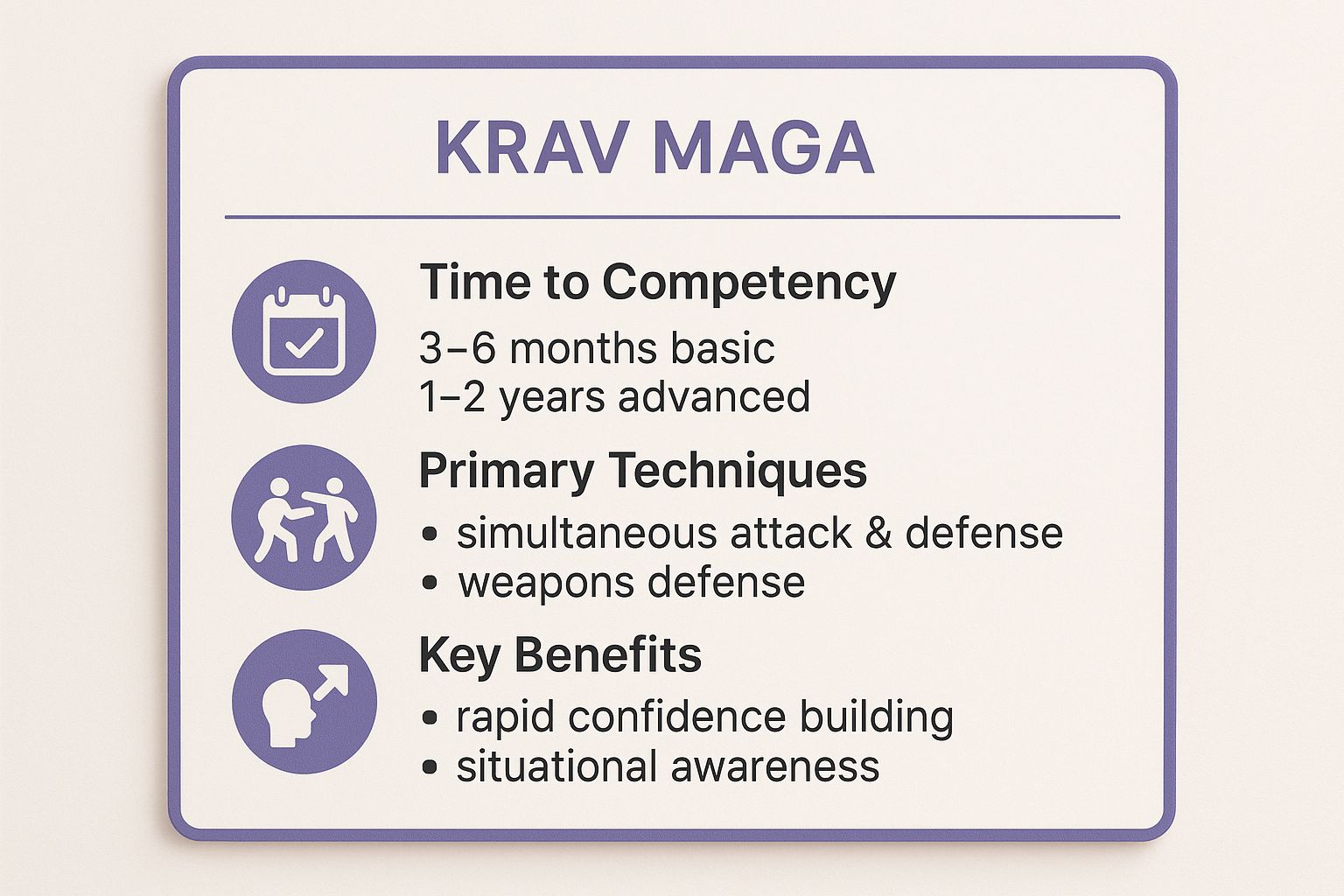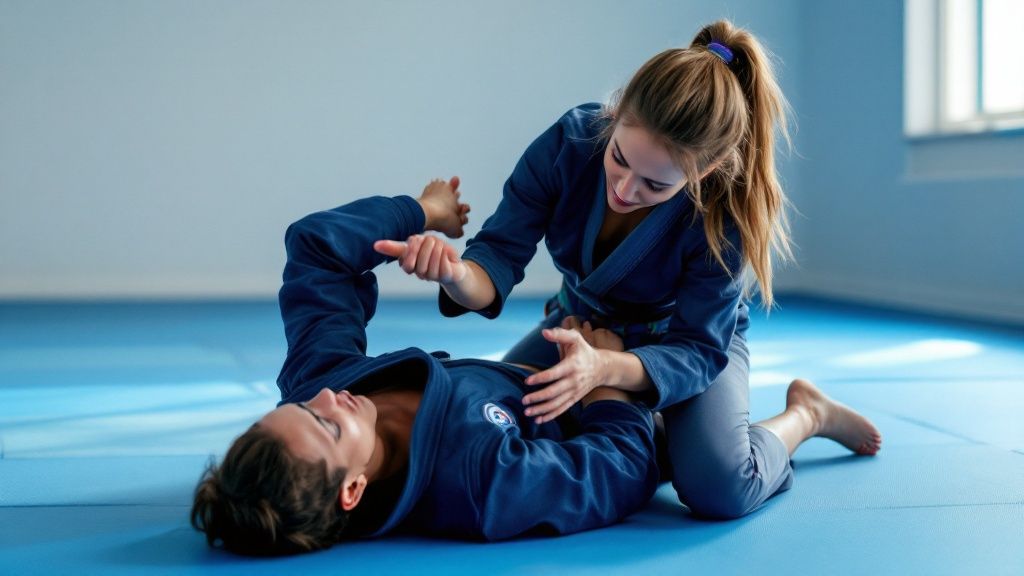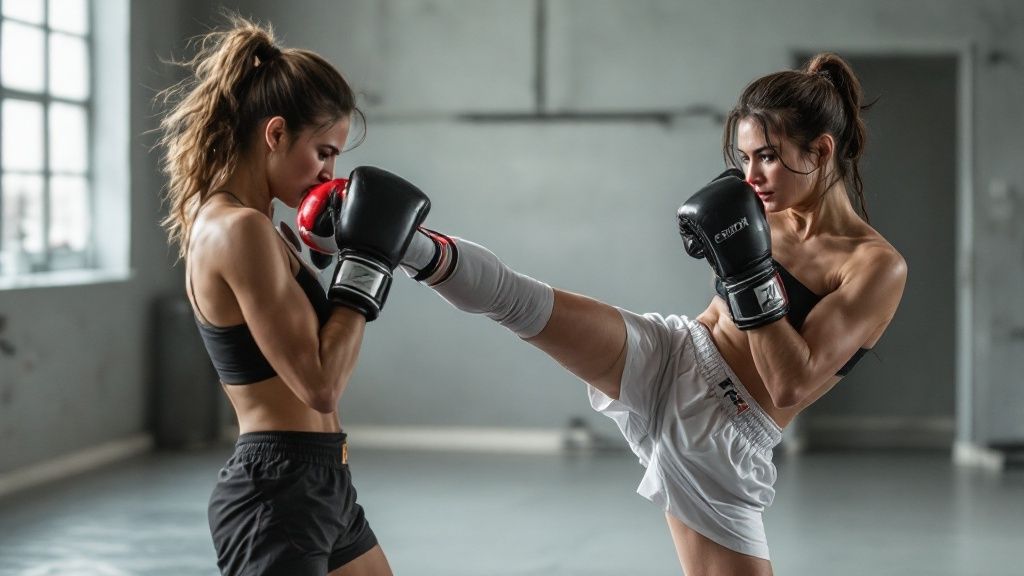

Discover the 8 best martial arts for women in 2025. Explore Krav Maga, BJJ, Muay Thai, and more for self-defense, fitness, and confidence.
In a world that constantly demands resilience, finding a discipline that builds both physical strength and mental fortitude is invaluable. Martial arts offers a unique pathway to empowerment, combining practical self-defense skills with profound personal growth. For women seeking to enhance their safety, fitness, and self-assurance, choosing the right discipline is a critical first step. This guide moves beyond basic recommendations to provide a detailed analysis of the best martial arts for women, helping you identify the style that aligns perfectly with your individual goals.
We understand that every woman's reason for training is different. Whether you are focused on real-world self-defense applications, seeking a high-intensity workout, or searching for a practice that cultivates mental clarity and community, the ideal martial art for you exists. This curated list breaks down the specific benefits and training realities of top disciplines like Krav Maga, Brazilian Jiu-Jitsu, and Muay Thai, among others. We will explore the core principles, typical class structures, and practical advantages of each style. This article is designed to equip you with the specific insights needed to make a confident and informed choice, setting you on a path toward unlocking your full potential and building unshakable strength from the inside out.
Born from the streets and refined by the Israeli military, Krav Maga is less a traditional martial art and more a tactical survival system. Its name translates to "contact combat," and its philosophy is brutally simple: neutralize threats as quickly and efficiently as possible. This makes it one of the best martial arts for women seeking practical, no-nonsense self-defense skills.
Krav Maga bypasses complex forms and katas, focusing instead on instinctive movements and aggressive counter-attacks. Training simulates real-world scenarios, teaching you how to defend against common street attacks, including grabs, chokes, and even weapon threats. It empowers you to turn everyday objects into improvised weapons and exploit an attacker's vulnerable points.
The system is designed to be effective regardless of size or strength. It teaches women to leverage their natural advantages and use powerful, direct strikes to an assailant’s most sensitive areas like the eyes, throat, and groin. This focus on practical application over prolonged fighting is critical for personal safety.
Key Insight: Krav Maga's core principle is "simultaneous defense and attack," meaning you block and strike in a single, explosive motion. This technique is designed to overwhelm an attacker and create an immediate opportunity for escape.
The infographic below summarizes the key attributes that make Krav Maga a powerful choice for women.

This quick reference highlights how Krav Maga offers a rapid path to practical self-defense proficiency, builds confidence, and sharpens situational awareness.
For those ready to begin, the path to proficiency is clear and actionable.
Developed by the Gracie family, Brazilian Jiu-Jitsu is a ground-based grappling art often called "the gentle art." It's founded on the principle that a smaller, weaker person can successfully defend against a bigger, stronger assailant by using leverage, proper technique, and taking the fight to the ground. This makes it one of the best martial arts for women, as it neutralizes the size and strength advantages common in self-defense situations.

BJJ training focuses almost entirely on grappling, teaching you how to control an opponent on the ground, escape from inferior positions, and apply submissions like joint locks and chokes. Unlike striking arts, it provides a clear solution for situations where you are pinned or taken to the ground, which is a common reality in attacks against women.
BJJ is a game of human chess that values intelligence and technique over raw power. It empowers women by teaching them how to use their entire body to generate leverage and control, making a significant size difference manageable. Learning how to escape from underneath a larger opponent and apply a finishing hold provides an incredible boost in confidence and real-world capability. The advantages of martial arts training are numerous, providing benefits beyond physical skills.
Key Insight: BJJ’s core philosophy is that most fights end up on the ground. By specializing in this domain, a smaller person can turn a position of disadvantage into one of control and tactical superiority.
The video below demonstrates some fundamental BJJ techniques that are crucial for self-defense.
This emphasis on ground control and submissions provides a practical and repeatable method for handling physical threats.
Beginning your journey in BJJ is accessible and incredibly rewarding with the right approach.
Hailing from Thailand and known as "The Art of Eight Limbs," Muay Thai is a powerful and respected striking martial art. It utilizes a full-body arsenal of punches, kicks, elbows, and knee strikes, making it a formidable stand-up combat system. Beyond its competitive aspect, it provides an intense physical workout that builds exceptional cardiovascular endurance, raw power, and mental fortitude.
The training is direct and pragmatic, focusing on generating maximum force with each strike. It also incorporates clinch work, a form of stand-up grappling that teaches you to control an opponent at close range. This comprehensive approach to striking and close-quarters control makes Muay Thai one of the best martial arts for women who want to build functional strength and confidence.

Muay Thai teaches women to generate devastating power using their entire body, not just arm strength. Techniques like sharp elbow strikes and powerful knee attacks are ideal for close-range self-defense, as they are effective in tight spaces and can neutralize a threat quickly. The conditioning, or "body hardening," involved in training also builds physical and mental resilience.
Key Insight: The Muay Thai clinch is a game-changer for self-defense. It teaches you how to control an attacker's head and upper body, creating opportunities to land debilitating knee and elbow strikes or to disengage and escape safely.
The art’s focus on practical, high-impact techniques provides a clear advantage in a real-world confrontation, where ending the conflict swiftly is the primary goal.
Beginning your Muay Thai journey involves a commitment to both technique and conditioning.
Developed by Morihei Ueshiba, Aikido is a unique Japanese martial art that translates to "the Way of harmonious spirit." It stands apart by focusing on blending with an attacker's motion to redirect their energy, rather than confronting force with force. This philosophy emphasizes neutralizing an attack and gaining control of the situation without causing unnecessary harm to the aggressor.
Aikido's techniques are built on circular movements, joint locks, pins, and throws that are executed by taking an opponent's balance. Training involves understanding timing, movement, and connection, making it a cerebral and graceful art. This makes it an excellent choice for women who prefer a method of self-defense that relies on technique and leverage over brute strength.
The core principle of Aikido is that a smaller, weaker person can successfully defend against a larger, stronger assailant. By using the attacker's own momentum against them, a woman can effectively unbalance and control a threat. This approach is not about winning a fight but about harmonizing with conflict to resolve it safely and efficiently.
Key Insight: Aikido's power comes from its use of kazushi, the principle of unbalancing an opponent. By disrupting an attacker's center of gravity, you nullify their strength advantage and create opportunities for throws or joint locks with minimal effort.
This emphasis on leverage and technique over raw power makes Aikido one of the best martial arts for women, offering a sustainable and intelligent path to personal safety. Its principles can be applied in various contexts, from managing physical confrontations to de-escalating verbal conflicts.
For those interested in this harmonious art, the journey is rewarding but requires patience.
Originating from Korea, Taekwondo is a martial art celebrated for its spectacular array of high, fast, and powerful kicking techniques. Translating to "the way of the foot and the fist," it has evolved into a global phenomenon and an Olympic sport. Its emphasis on speed, agility, and dynamic leg strikes makes it a unique and effective system for women seeking to build incredible physical fitness and self-defense capabilities.
Taekwondo training develops exceptional flexibility, cardiovascular endurance, and explosive leg strength. It teaches practitioners how to control distance, using long-range kicks to keep an attacker at bay. While famous for its acrobatic and sport-oriented techniques, its foundational principles provide a solid base for practical self-defense, focusing on generating maximum force from a safe distance.
Taekwondo’s focus on leg techniques is a significant advantage for women, as the legs are typically much stronger than the arms. It teaches you to use your most powerful weapons to strike an opponent's vulnerable areas from a distance, minimizing the need to engage in close-quarters grappling. This principle of maintaining space is a cornerstone of effective self-defense strategy.
Key Insight: The power of a Taekwondo kick, such as the side kick or front kick, is not just for sport. When aimed at a vulnerable target like the knee or groin, it becomes a powerful, disabling tool that can create an immediate opportunity to escape an unsafe situation.
The art’s emphasis on speed and agility builds reflexes and coordination, which are crucial attributes for reacting effectively under duress. This makes Taekwondo one of the best martial arts for women who want to blend athletic prowess with practical safety skills.
Beginning your Taekwondo journey is accessible and structured, with a clear path for progression.
Developed in Southern China, Wing Chun is a unique and efficient martial art designed for close-quarters combat. Legend attributes its creation to a Buddhist nun named Ng Mui, who designed a system that relies on structure, simultaneous blocking and striking, and straight-line attacks rather than brute strength. This historical foundation makes it an especially fitting choice as one of the best martial arts for women.
Wing Chun's core principles revolve around protecting your "centerline" while exploiting your opponent's. It bypasses wide, looping motions in favor of rapid-fire chain punches and low kicks delivered with maximum efficiency. Practitioners learn to use sensitivity and trapping techniques to control an attacker's limbs, redirecting their force and creating openings for counter-attacks in tight spaces like hallways or elevators.
The art is engineered for smaller individuals to overcome larger, stronger opponents. It teaches women to use body mechanics and structure, not muscle, to generate power and maintain a strong defensive guard. Its focus on close-range combat is ideal for the types of confrontations women are more likely to face, such as grabs or being cornered.
Key Insight: Wing Chun's "centerline theory" is its strategic foundation. By maintaining control of the imaginary line running down the center of your body and attacking your opponent's, you can defend and strike along the most direct and efficient path.
The art’s emphasis on economy of motion ensures that no energy is wasted, allowing a smaller defender to effectively neutralize a threat quickly and decisively.
Beginning your journey in Wing Chun involves building a strong foundation in its unique principles.
Developed in Japan by Jigoro Kano, Judo is a powerful martial art and Olympic sport that translates to "the gentle way." Its philosophy is centered on using an opponent's own momentum and force against them, making it an exceptional choice for women's self-defense. Judo bypasses striking, focusing instead on throws, grappling, pins, joint locks, and chokes to control and subdue an aggressor.
Training in Judo is highly practical, teaching you how to unbalance and throw a larger, stronger opponent using leverage and technique rather than sheer force. This focus on "maximum efficiency with minimum effort" makes it a strategic and intelligent martial art, ideal for those who want to learn how to de-escalate or end a confrontation without relying on powerful strikes.
Judo's greatest advantage is its emphasis on leverage. It trains women to close the distance with an attacker, use their body weight effectively, and execute powerful throws that can neutralize a threat instantly. Because many physical altercations end up on the ground, Judo’s extensive training in ground control, or newaza, provides critical skills for pinning an opponent and escaping from dangerous positions.
Key Insight: Judo’s core principle is seiryoku zen'yō (maximum efficiency, minimum effort). This means a smaller person can effectively control a larger one by applying technical skill and precise timing, turning an attacker's strength into their biggest weakness.
The discipline required in the dojo also helps improve student engagement, a key factor in long-term skill development. You can learn more about how dojos foster this engagement on martialytics.com. The combination of physical technique and mental discipline makes Judo one of the best martial arts for women.
For those ready to embrace the "gentle way," the journey begins with mastering the fundamentals.
Often called "the sweet science," boxing is a powerful combat sport that relies on sophisticated footwork, head movement, and powerful punching. While known for its competitive aspect, boxing provides a phenomenal fitness regimen and practical self-defense skills, making it one of the best martial arts for women looking to build confidence and strength.
Boxing training goes far beyond just throwing punches. It develops incredible cardiovascular endurance, agility, and hand-eye coordination. You learn to control distance, anticipate an opponent's moves, and deliver precise, powerful strikes. The focus is on using your entire body to generate force, from your feet up through your core and into your fists.
Boxing equips women with one of the most effective and easily learned self-defense tools: a powerful punch. Training teaches you how to strike with proper form to maximize impact and avoid injury. More importantly, it builds the reflexes and muscle memory to react instinctively under pressure, using footwork and defensive head movement to evade an aggressor's attack while creating an opening to counter-strike and escape.
Key Insight: Boxing's emphasis on footwork and head movement is a game-changer for self-defense. It teaches you to be a moving target, making it incredibly difficult for an attacker to land a blow or maintain a grab, giving you the critical space needed to defend yourself effectively.
This emphasis on mobility, power, and defensive awareness provides a robust foundation for personal safety.
Getting into the ring, or even just a fitness class, is more accessible than ever.
You've explored the dynamic world of martial arts, from the battle-tested efficiency of Krav Maga to the strategic ground game of Brazilian Jiu-Jitsu and the powerful striking of Muay Thai. We've delved into the fluid redirection of Aikido, the acrobatic kicks of Taekwondo, the close-range trapping of Wing Chun, the leverage-based throws of Judo, and the foundational footwork of Boxing. Each discipline offers a unique pathway to self-defense, fitness, and personal growth.
The central takeaway is that there is no single "best" martial art for women; there is only the best martial art for you. Your personal goals are the most important compass in this journey. Are you seeking a high-intensity workout, practical self-defense skills for real-world scenarios, a disciplined mental practice, or a competitive sport? Answering this question honestly will narrow down your options significantly.
The transition from reading about martial arts to practicing them is the most critical step. Knowledge is potential, but action creates transformation. Here’s a simple, actionable plan to get started:
Key Insight: The quality of the instructor and the culture of the school are often more important than the specific martial art you choose. A great teacher in any discipline will provide a foundation of confidence and skill that transcends style.
Embracing martial arts is about more than learning to fight; it's about discovering your own resilience, discipline, and inner strength. The journey will challenge you, but it will also empower you in ways that extend far beyond the training mat. Every class you attend builds not just muscle and technique, but a profound sense of self-assurance that will impact every area of your life. The path begins not with a perfect choice, but with the courageous first step onto the mat.
For martial arts school owners dedicated to building an inclusive and thriving community, managing the administrative side is key. Martialytics helps you streamline student sign-ups, automate billing, and manage class schedules, freeing you to focus on delivering world-class instruction that empowers every student, especially women starting their journey. Learn how Martialytics can help your school grow.


No credit card required. No lock in contracts. Start your 30-day free trial to see immediate improvements.

Book your free demo with one of the co-founders of Martialytics, Brad or Allen, depending on your time-zone.
We'll do this on Zoom video conferencing software for awesome screen sharing so please make sure you have the app or are good to go before the time starts.